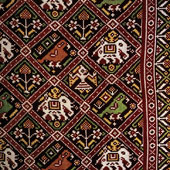Patola Saree Weaving - Patan
Patola weaving is one of the difficult forms of weaving in the world. It follows the double ikat (tie and dye) style for the warp and weft yarns dyed according to the pre-design pattern before dyeing. Patan of Gujarat in India is one of the places where few of the weavers still practice this craft. At one time silk were woven in the most of the cities of Gujarat, Jalna in Maharashtra and Burhanpur in Madhya Pradesh. Usually the flora, fauna, elephant style, flower motifs, jewels, abstract geometrical patterns, dancing maidens are some of the patterns were done as a border of sarees, where the craftsmen visualize the pattern of dyeing for the warp and weft yarns. These yarns are woven zigzag at even place so that the warp and the weft yarns meet precisely towards the right place to achieve the desired patterns style and colorful diversity. Patola is characterized by its intricate -bold pattern, juxtaposed with figurative motifs tied and dyed till the complete pattern to be obtained are created.
As per the craftsmen, King Kumarpala in around 12th century had shifted to Patan and initiated about 700 weavers for the Patola weaving. It takes about six months to a year of time for making the Patola fabric from pre-loom to post- loom. King ensured that there were regular supplies of the new Patola fabric every morning for his visit to the temple, where the fabric being considered as pure and auspicious. There was a custom followed in this region that, during the ceremony of the Shrimanta (Godbharai in Hindi) i.e. during the ritual of the seventh month of the pregnancy of a woman, patola saree with figures of dancing women, elephant and parrot is usually gifted to her. It is also gifted to the Gujarati woman and girl as a sign of social status that she maintains as her own property in her wedded household. Few of the silk weavers from the Slavi caste, whose ancestors basically originates from the states of Karnataka and Maharashtra chose Gujarat as their domicile for the skills of making the Patola saree during the 12th century.








